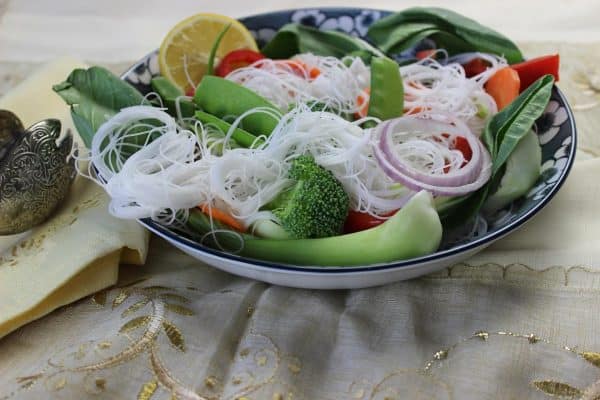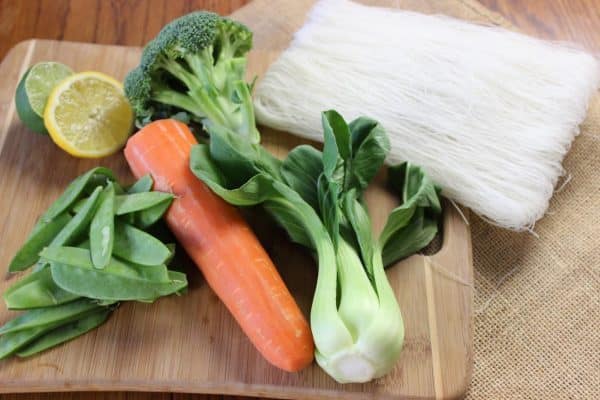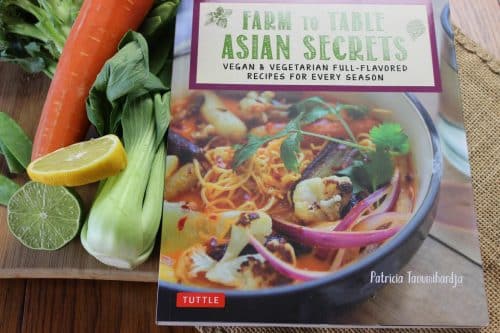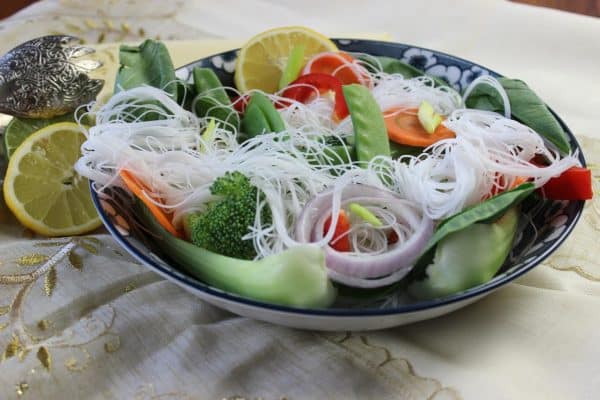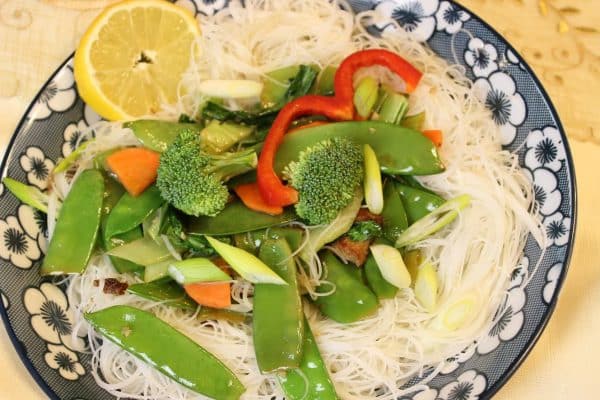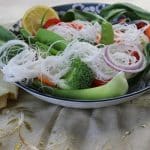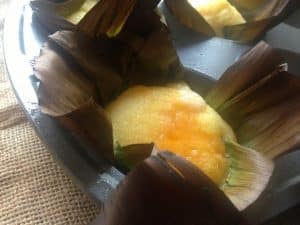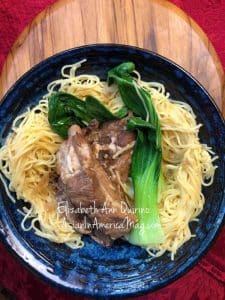Stir-Fry Noodles and Vegetables
As an Amazon Associate and member of other affiliate programs, I earn from qualifying purchases.
More and more Filipinos are switching to vegetarian dishes so I am often asked if I have such recipes on my blog. Thus, I enjoyed cooking this Stir-Fry Noodles with Vegetables.
I was so happy to receive the cookbook “Farm to Table Asian Secrets” by Patricia Tanumihardja. This is the second cookbook I am enjoying from this talented author and friend. A while ago, I was happy to help Pat with recipe testing for this cookbook project and I am grateful she mentioned me in the Acknowledgements.
The author is well informed on various vegetables in the Asian region and how best to cook them in a myriad of dishes here in America. I am amazed at the large variety of recipes Pat created for this cookbook. I admit I am not a vegetarian so my knowledge on this topic is limited to the vegetables I grew up with in the Philippines and the ones I buy here in the Jersey suburbs. But my family thrives on vegetables everyday so I am always on the lookout for a new dish with the familiar flavors we are used to.
For instance, in this recipe entitled ‘Stir-Fry Cellophane Noodles with Vegetables’ in the cookbook, I immediately found a link to the Filipino flavors my family and I enjoy. The author used cellophane or what we know as ‘sotanghon’ noodles. I knew this dish would be a hit at our table. I tried the recipe using dried Chinese Noodles or what we call ‘bihon’ noodles. Honestly, the outcome was a marvelous vegetarian version of pancit bihon. The bihon noodles appealed to my family right away. It also helped extend the dish and gave us the hearty, satisfying feeling after we enjoyed it. As the author suggested, I used lemon juice but also added calamansi, the Filipino lime. The sweet piercing citrusy flavor of calamansi blended well with the fresh lemons. Nothing was left on our plates after that.
In her new 144-page cookbook, the author wants to show readers these three things: First, to show vegetarians, vegans and omnivores that vegetable-focused meals can be incredibly tasty and satisfying. Second, to encourage readers to learn a few ‘secret’ Asian techniques and tricks. Third, to demystify Asian cooking and prove that it’s quick and easy.
The author also shares secrets of vegetarian and vegan Asian cooking. She shows how to blend flavors, textures, aromas and colors to create full-flavored vegetable dishes. Each chapter is based on seasonal vegetables. There are also recipes for produce one finds year-round.
Pat is an experienced food writer and an expert on Asian and sustainable farm-to-table cooking. I have complete trust in her culinary expertise on this topic and I am glad I found a great resource for Asian and Filipino vegetarian dishes. I’ll gladly recommend this cookbook to friends who relish their veggies.
Stir-Fry Noodles and Vegetables
Equipment
- large skillet or wok
Ingredients
- 4 cups (1 liter) low-sodium vegetable stock
- 250 gram (8 oz.) dried rice noodles or Filipino Pancit Bihon noodles
- 2 Tablespoons vegetable oil
- 2 cloves garlic minced
- 1 whole onion sliced
- 2 cups sliced broccoli
- 2 cups sugar snap peas edges trimmed
- 1 bundle (3 cups) shredded bok choy
- 2 large carrots peeled, julienne strips
- 1 whole large red bell pepper sliced
- 1 teaspoon salt
- 1/2 teaspoon -ground black pepper
- 1 teaspoon granulated sugar
- 3 stalks scallions cut into 1-inch pieces
- 1/4 cup soy sauce
- 3 Tablespoons fresh lemon juice plus lemon wedges for serving
- 2 Tablespoons calamansi juice fresh or frozen
Instructions
- In a medium-sized stockpot, over medium high heat, heat and boil the vegetable stock. After it has boiled, remove the vegetable stock from the stove. Soak the noodles for about 20 minutes. Then drain the noodles and set aside. Note: do not soak the noodles too long or they get mushy.
- In a large skillet or wok, over medium high heat, add the vegetable oil. Saute the garlic and onions for 1 to 2 minutes.
- Add the broccoli, and snap peas. Then add the chopped bok choy. Blend ingredients well. Season with salt and black pepper.
- To the skillet of vegetables, add the carrots and red bell pepper slices. Stir ingredients together and add the sugar.
- Take the bihon noodles and separate them with a fork if needed. Place the noodles into the vegetable mixture.
- Sprinkle the soy sauce, lemon and calamansi juice all over. Toss and combine the ingredients well.
- Garnish with scallions and additional wedges of lemon or slices of calamansi. Serve warm.
- Cook's comments: The author suggests serving chili paste such as sambal oelek in small dishes on the side. The original recipe used cellophane or sotanghon noodles. Feel free to use sotanghon if preferred.
- Author's Cooking Tips: In the cookbook, the author mentions pancit is a potluck favorite for many Filipinos and Asians. The versatility of the dish for any occasion is one of the reasons for that. The author also suggests these additional tips: if you have fried shallots or crisp fried garlic on hand, sprinkle them on top of this dish. Or if you have tofu, mushrooms or egg, feel free to add to this recipe if desired.
- About the Author: Patricia Tanumihardja is an experienced food writer and an expert on Asian and sustainable farm-to-table cooking. Follow her, her writings and recipes for more on this topic. Read more about the author on her site Pickles & Tea.
- Disclosure: I received a copy of the cookbook from the author as a gift. I was not paid to review this cookbook or recipe. But I will gladly recommend this as a good resource for Asian vegetarian and vegan cooking.
- Hello, Friends! All the images and content on this blog are COPYRIGHT PROTECTED and owned by my media company Besa-Quirino LLC. This means BY LAW you are NOT allowed to copy, scrape, lift, frame, plagiarize or use my photos and recipe content I wrote, on your website, films or videos without my permission. If you want to republish this recipe or content on another website, video or news article, please ASK my permission, re-write it in your own words and simply link back to this blog to give proper attribution. It’s the legal thing to do. Thank you. Email me at [email protected]
Nutrition
Notes on Nutrition: The nutrition information provided is an estimate and will vary based on cooking methods and specific brands of ingredients used.
Did you like this recipe?I have more Filipino Instant Pot recipes in my newest cookbook Instant Filipino Recipes: My Mother’s Traditional Philippine Cooking in A Multicooker Pot by Elizabeth Ann Besa-Quirino. I also have more classic recipes inspired by my mother’s cooking in my popular cookbook: My Mother’s Philippine Recipes. If you’re learning how to cook Filipino food or a fan of Philippine cuisine, buy my cookbooks and books on Amazon.com sold worldwide in paperback and Kindle format.
Copyright Notice: Hello, Friends! Please DO NOT LIFT OR PLAGIARIZE my original recipe, stories, photos or videos. All the images and content on this blog are COPYRIGHT PROTECTED and owned by my media company Besa-Quirino LLC. This means BY LAW you are NOT allowed to copy, scrape, lift, frame, plagiarize or use my photos, essays, stories and recipe content on your websites, books, films, television shows, videos, without my permission. If you wish to republish this recipe or content on media outlets mentioned above, please ASK MY PERMISSION, or re-write it in your own words and link back to my blog AsianInAmericaMag.com to give proper attribution. It is the legal thing to do. Thank you. Email me at [email protected]

